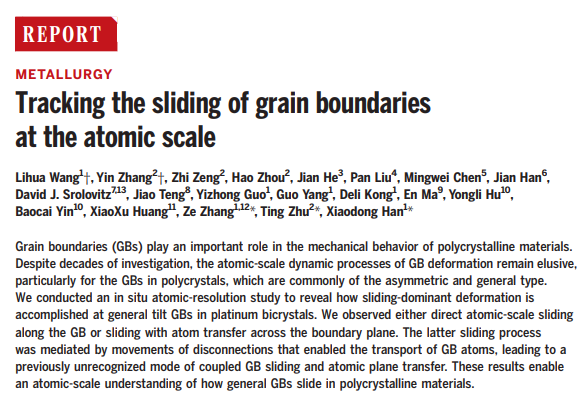On March 18, Tracking the sliding of grain boundaries at the atomic scale was published in the top academic journal Science (Science, DOI: 10.1126/science.abm2612). The lead authors of the article are Wang Lihua from the Faculty of Materials and Manufacturing, Beijing University of Technology (BJUT) and Zhang Yin from Georgia Institute of Technology (Georgia Tech), U.S. The corresponding authors are Professor Han Xiaodong from BJUT, Professor Zhu Ting from Georgia Tech, and Professor Zhang Ze from Zhejiang University (member of the Chinese Academy of Sciences and former vice-president of BJUT). It is the first article published in Science with BJUT quoted as the primary organization, and a milestone for BJUT's research on the atomic mechanism of grain boundary sliding plasticity.

Grain boundaries (GBs) play an important role in the mechanical behavior of polycrystalline materials. Despite decades of investigation and due to the lack of effective experimental methods and devices, the atomic-scale dynamic processes of GB deformation remain elusive, particularly for the GBs in polycrystals, which are commonly of the asymmetric and general types.

Leveraging on the original atomic resolution in situ mechanical experimental research device in the Institute of Microstructure and Property of Advanced Materials of BJUT, the team conducted an in situ atomic-resolution study to reveal how sliding-dominant deformation is accomplished at general tilt GBs in platinum bicrystals, and to observe either direct atomic-scale sliding along the GB or sliding with atom transfer across the boundary plane. The latter sliding process was mediated by movements of disconnections that enabled the transport of GB atoms, leading to a previously unrecognized mode of coupled GB sliding and atomic plane transfer. These results enable an atomic-scale understanding of how general GBs slide in polycrystalline materials.
During the period of the 14th Five-Year Plan, the faculty and staff in BJUT will strive to explore deeply into the breadth and depth of science and technology, contributing their expertise to the scientific and technological progress.
Authors Information:
Professor Wang Lihua obtained his doctoral degree from BJUT in 2012 and conducted post-doctoral research at the University of Queensland from 2015 to 2017. He has long been engaged in research on in situ atomic-scale deformation mechanisms of materials and distinguished himself with several experimental breakthroughs in the area, and was granted by the National Science Foundation for Outstanding Young Scholars. He has published over 70 articles, including one in Science, five in Nat. Commun., two in Phys. Rev. Lett., four in Nano Lett., four in Acta Mater., four in ACS Nano, and six in Scripta Mater. He also holds four patents. He has undertaken several national and provincial research projects.
Professor Zhang Ze, member of the Chinese Academy of Sciences and former vice-president of BJUT. Professor Zhang Ze has long been engaged in the research on the electron microstructure of advanced materials, and has made significant innovative achievements in in situ structural evolution and servicing performance correlation of materials. His team won the second prize of the State Natural Science Award in 2021.
Professor Han Xiaodong has long been engaged in research on mechanical behaviors of materials, atomic-level mechanisms, and other fundamental issues in the discipline and their methodology and experimental techniques, and was granted by the National Science Foundation for Distinguished Young Scholars. Their key technologies have been awarded thirty-three patents globally, including three in the U.S., one PCT patent, and twenty-seven invention patents in China. The team won the second prize of the State Natural Science Award in 2021. Professor Han has published over 230 high-quality articles in Science, Nature Mater., Nature Comm., Nano Lett, Phys Rev Lett, and Acta Mater, and undertaken several projects under national key research and development programs.





